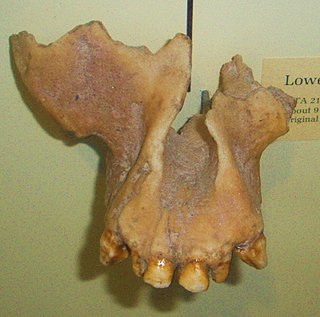 W
WAnkarapithecus is a genus of extinct ape. It was probably frugivorous, and would have weighed about 27 kilograms (60 lb). Its remains were found close to Ankara in central Turkey beginning in the 1950s. It lived during the Late Miocene and was similar to Sivapithecus.
 W
WApeomyoides savagei is a fossil rodent from the Miocene of the United States, the only species in the genus Apeomyoides. It is known from fragmentary jaws and isolated teeth from a site in the early Barstovian, around 15–16 million years ago, of Nevada. Together with other species from scattered localities in the United States, Japan, and Europe, Apeomyoides is classified in the subfamily Apeomyinae of the extinct rodent family Eomyidae. Apeomyines are a rare but widespread group that may have been adapted to a relatively dry habitat.
 W
WArchaeoindris fontoynontii is an extinct giant lemur and the largest primate known to have evolved on Madagascar, comparable in size to a male gorilla. It belonged to a family of extinct lemurs known as "sloth lemurs" (Palaeopropithecidae), and because of its extremely large size, it has been compared to the ground sloths that once roamed North and South America. It was most closely related to Palaeopropithecus, the second largest type of sloth lemur. Along with the other sloth lemurs, Archaeoindris was related to the living indri, sifakas, and woolly lemurs, as well as the recently extinct monkey lemurs (Archaeolemuridae). The genus, Archaeoindris, translates to "ancient indri-like lemur", even though it probably became extinct recently, around 350 BCE.
 W
WBirgerbohlinia is an extinct genus of Giraffidae. It was first named by Crusafont Pairó and Villalta in 1951 and was found in Crevillente-2.
 W
WBrygmophyseter, known as the biting sperm whale, is an extinct genus of toothed whale in the sperm whale family with one species, B. shigensis. When it was first described in 1994, the species was placed in the genus Scaldicetus based on tooth morphology, but this was later revised in 1995. In 2006, it was classified into the genus Naganocetus, which is considered to be a junior synonym. The only known specimen, a nearly complete skeleton, was dated to be around 14–15 million years old. Brygmophyseter is thought to have been 7 meters (23 ft) long, and it probably had 11 or 12 teeth in the upper and lower jaws. Brygmophyseter is part of a group of macroraptorial sperm whales which tended to be apex predators using their large teeth to catch struggling prey such as whales. It had a spermaceti organ which was probably used for biosonar like in the modern sperm whale. The whale has made an appearance on The History Channel's TV series Jurassic Fight Club.
 W
WCorriebaatar is the type and only genus of Corriebaataridae, a family of multituberculate mammals. It contains the single species Corriebaatar marywaltersae and represents the first evidence of Australian multituberculates Fossils found in the Wonthaggi Formation date back to the Aptian stage of the Early Cretaceous.
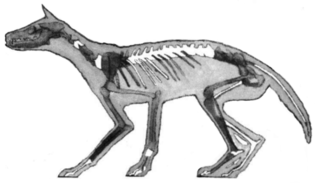 W
WThe Sardinian dhole is an extinct insular canid which was endemic to what is now the Mediterranean islands of Sardinia (Italy) and Corsica (France), which were joined for much of the Pleistocene. It went extinct when humans began to settle on the island. Its scientific name means "dog-beast of Sardinia", the genus name from the Ancient Greek: θήρ, romanized: thḗr, lit. 'beast', 'wild animal' and κύων, kyōn, 'dog' and the specific name from the Latin: Sardous, lit. 'of Sardinia', alt. form of Latin: Sardus.
 W
WDenebola is an extinct genus of whale belonging to the family Monodontidae. It contains a single known species, Denebola brachycephala. It is the earliest known ancestor of the beluga, Delphinapterus leucas, and dates from the Upper Miocene period. A fossil was found in the Baja California peninsula, indicating that the family once existed in warmer waters.
 W
WDiatomys is an extinct rodent genus known from Miocene deposits in China, Japan, Pakistan, and Thailand. The fossil range is from the late Early Miocene to the Middle Miocene.
 W
WDiprotodon is an extinct genus of large marsupials native to Australia from the Pleistocene epoch. It is considered one of Australia's core species of "megafauna", which ranged throughout the continent during the Pleistocene. The genus is currently considered monotypic, containing only Diprotodon optatum, the largest known marsupial to have ever existed. The word diprotodon is constructed from the Ancient Greek words for 'two forward teeth'. Diprotodon existed from about 1.6 million years ago until extinction some 44,000 years ago.
 W
WEkorus ekakeran is a large extinct mustelid mammal. Fossils, including largely complete skeletons, are known from the late Miocene of Kenya.
 W
WEritherium is an extinct genus of early Proboscidea found in the Ouled Abdoun basin, Morocco. It lived about 60 million years ago. It was first named by Emmanuel Gheerbrant in 2009 and the type species is Eritherium azzouzorum. Eritherium is the oldest, smallest and most primitive known elephant relative.
 W
WHulitherium tomasetti is an extinct zygomaturine marsupial from New Guinea during the Pleistocene. The species name honours Berard Tomasetti, a Catholic priest in Papua New Guinea, who brought the fossils to the attention of experts.
 W
WImagotaria is an extinct monotypic genus of walrus with the sole species Imagotaria downsi. Fossils of Imagotaria are known from the early late Miocene of California.
 W
WIranotherium was a genus of large elasmotheriine rhinoceros, comparable in size to a modern white rhino. It is known from the Late Miocene (Tortonian) of Maragha, Iran and the middle part of the Liushu formation of northwestern China. It was a precursor to the related Sinotherium and may have been ultimately outcompeted by its descendant. This species is most well known for showing unique sexual dimorphism among rhinos.
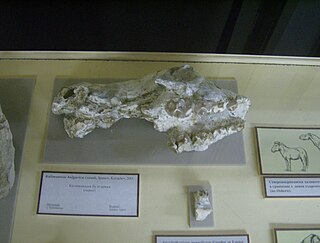 W
WKalimantsia is an extinct chalicothere from the Miocene of Bulgaria, Europe. It contains one species, K. bulgarica.
 W
WLlanocetus is a genus of extinct toothed baleen whales from the Late Eocene of Antarctica and Bangladesh. The type species, Llanocetus denticrinatus, reached gigantic proportions, with the juvenile specimen reaching an estimated 8 m (26 ft) in length; a second, unnamed species, known only from three isolated premolar teeth, reached an estimated total body length of up to 12 m (39 ft). Like other contemporary baleen whales of the Eocene, Llanocetus completely lacked baleen in its jaws. It was probably a suction feeder like the modern beaked and pygmy right whales.
 W
WMaastrichtidelphys is a Late Cretaceous genus of metatherian mammal from the Netherlands in Europe. The genus contains a single species, M. meurismeti. It is known from an extremely small right upper molar, and analysis of it suggests that Maastrichtidelphys is most closely related to the North American herpetotheriid marsupial, Nortedelphys, which is Lancian in age.
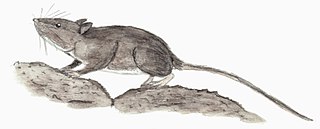 W
WThe lava mouse is an extinct endemic rodent from the Canary Islands, Spain. It is the only species in the genus Malpaisomys.
 W
WMegaceroides algericus is an extinct species of deer known from the Late Pleistocene to Holocene of North Africa. It is one of only two species of deer known to have been native to the African continent, alongside the Barbary stag, a subspecies of red deer. It is considered to be closely related to the giant deer species of Eurasia.
 W
WMegalenhydris barbaricina is a Late Pleistocene giant otter from Sardinia. It is known from a single skeleton, discovered in the Grotta di Ispinigoli near Dorgali, and was described in 1987. The species is one of four extinct otter species from Sardinia. The others are Algarolutra majori, Lutra castiglionis and Sardolutra ichnusae. This otter was large, much larger size needed than the other species. The structure of the teeth points to a diet of shellfish and/or crustaceans. A special characteristic of the species is the flattening of the first few caudal vertebrae. This might point to a slightly flattened tail.
 W
WNanodobenus is an extinct genus of pinniped that lived approximately 15.97 to 7.246 mya during the Miocene in what is now Baja California Sur, Mexico. It belonged to the family Odobenidae, the only extant species of which is the walrus.
 W
WOnychonycteris is the more primitive of the two oldest known monospecific genera of bat, having lived in the area that is current day Wyoming during the Eocene period, 52.5 million years ago.
 W
WPappotherium is an extinct genus of mammals from the Albian of Texas, US, known from a fossilized maxilla fragment bearing two tribosphenic molars, discovered within the Glen Rose Formation near Decatur, Wise County, Texas.
 W
WPholidocercus is an extinct monotypic genus of mammal from the Messel pit related to and resembling the modern-day hedgehog with a single species, Pholidocercus hassiacus. Like the hedgehog, it was covered in thin spines. Unlike hedgehogs, it had scales on its head in a helmet-like formation, and had a long, thick, scaled tail.
 W
WPhosphatherium escuillei is a basal proboscidean that lived from the Late Paleocene to the early stages of the Ypresian age until the early Thanetian some 56 million years ago in North Africa. Research has suggested that Phosphatherium existed during the Eocene period.
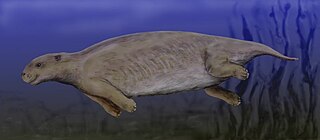 W
WProrastomus sirenoides is an extinct species of primitive sirenian that lived during the Eocene Epoch 40 million years ago in Jamaica.
 W
WSardolutra ichnusae is an extinct species of otter from the Late Pleistocene of Sardinia. It was originally described as Nesolutra ichnusae. It was a rather small species of otter, probably living in the sea. Among its characteristics is a relatively very large baculum, larger than in any living otter. The species probably evolved from a species of Lutra, maybe L. castiglionis.
 W
WShenshou is a haramiyidan dating from the Oxfordian stage of the Late Jurassic, approximately 160 million years ago. Fossils were recovered from the Tiaojishan Formation in the Liaoning province of China.
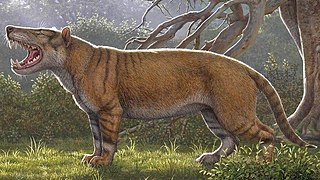 W
WSimbakubwa kutokaafrika is an extinct species of mammal of the family Hyainailouridae in the order Hyaenodonta. It lived during the early Miocene of Kenya. The type specimen was recovered from deposits dated to be 23 million years old. Possibly reaching up to 1,500 kg (3,300 lb), it might have surpassed the modern polar bear in size.
 W
WTangaroasaurus is an extinct genus of squalodontid whale from the Miocene of New Zealand. It contains a single species, Tangaroasaurus kakanuiensis. Similar to Basilosaurus and its close relative Squalodon, it was originally thought to be a species of marine reptile. Parts of the Holotype are presumably lost. Its name comes from Tangaroa, the Maori god of the sea, while the suffix -saurus comes from the Latin word for reptile, the group that Tangaroasaurus was originally placed in.
 W
WTitanocetus is a genus of extinct cetaceans closely related to the family Cetotheriidae.
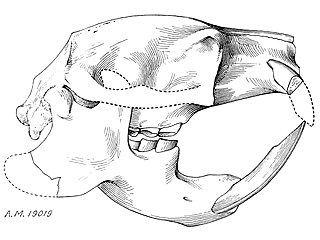 W
WTsaganomys altaicus is an extinct species of rodent from Asia, and the only species in the genus Tsaganomys.